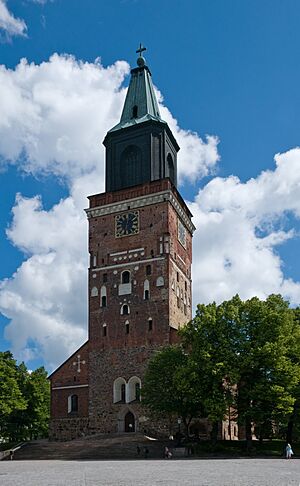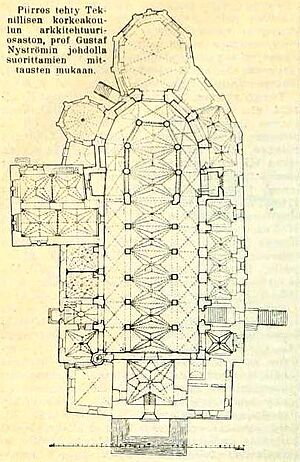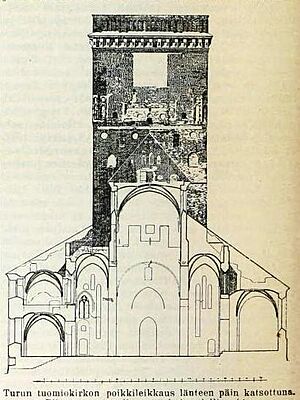Turku Cathedral facts for kids
Quick facts for kids Turku Cathedral |
|
|---|---|
|
Turun tuomiokirkko
|
|

Frontside of Turku Cathedral in summer 2008
|
|
| 60°27′09″N 22°16′41″E / 60.4524°N 22.2781°E | |
| Location | Turku |
| Country | Finland |
| Denomination | Evangelical Lutheran Church of Finland |
| Previous denomination | Catholic |
| Website | Official Website: http://www.turunseurakunnat.fi/portal/en/turku_cathedral/ |
| History | |
| Status | Episcopal polity |
| Dedication | Blessed Virgin Mary Saint Henry |
| Consecrated | June 17, 1300 |
| Architecture | |
| Architectural type | Church |
| Style | Gothic, Romanesque, Gothic Revival |
| Years built | 1276–1300 |
| Completed | 1300 |
| Specifications | |
| Capacity | 1,400 people |
| Length | 89 m |
| Width | 38 m |
| Height | 85.53 m |
| Administration | |
| Archdiocese | Turku |
| Province | Western Finland |
Turku Cathedral (Finnish: Turun tuomiokirkko, Swedish: Åbo domkyrka) is a very old and important church in Finland. It is the only medieval basilica in the country. A basilica is a large, important church building. It is also the main church for the Evangelical Lutheran Church of Finland. This means it is like the "mother church" for many other churches. The cathedral is the main church for the Archdiocese of Turku and where the Archbishop of Finland, Tapio Luoma, works. It is also a key part of Finland's building history.
Many people think Turku Cathedral is the most important religious building in Finland. It has seen many big moments in the country's past. It has become a well-known symbol of the city of Turku. The cathedral is in the center of Turku, right next to the Old Great Square. It is also by the Aura River. You can even hear its bells ring at noon on national radio! The cathedral is also very important for Finland's yearly Christmas celebrations.
The first version of the cathedral was made of wood in the late 1200s. It became the main cathedral of Finland in 1300. At that time, it was the seat of the Catholic bishop of Turku. Over the 1300s and 1400s, it was made much bigger. Stone was the main material used for these changes. A big fire, called the Great Fire of Turku, badly damaged the cathedral in 1827. After the fire, it was mostly rebuilt.
Contents
History of Turku Cathedral
As Turku grew into Finland's most important trading city in the 1200s, the Bishop's office moved there. It moved from Koroinen, which was a bit further up the Aura River. By the end of the 1200s, a new stone church was finished. It was built where an older wooden church once stood on Unikankare Mound. On June 17, 1300, Bishop Magnus I officially opened it. It was named the Cathedral Church of the Blessed Virgin Mary and Saint Henry. Saint Henry was the first Bishop of Finland.
How the Cathedral Grew Over Time
When it was first built, the cathedral was smaller than it is today. Its front was where the pulpit is now. The roof was also much lower. The cathedral was made bigger many times during the Middle Ages. A new choir section was added in the 1300s. The tall, eight-sided Gothic pillars in the main church area come from this time. For a long time, the main altar was in the middle of the church. In the mid-1600s, it moved to its current spot in the apse. This area used to be the Chapel of All Saints.
In the 1400s, small chapels were added along the sides of the main church hall. These chapels had altars for different saints. One important chapel holds the tomb of Bishop Hemming of Turku. He lived from 1290 to 1366 and was the 12th bishop. Bishop Hemming helped Turku Cathedral a lot. He made sure big repairs happened in the 1300s. He was also a good friend of Saint Birgitta of Sweden.
Bishop Hemming was first buried in the choir of the cathedral. In 1514, his remains were moved to a special spot on the north side of the church. This happened after Pope Leo X recognized him as blessed. His remains were placed in a wooden chest. This chest is decorated in a style from the early 1500s. Even though its colors have faded, you can still see hints of gold, yellow, blue, and red. It must have been very bright when it was new. The chest is in a dark spot near the pulpit. But its location by the aisle made it easy for people to visit. This was important because of its special status.
Another important person buried in the cathedral is Queen consort Karin Månsdotter (1550–1612). She was Queen of Sweden for a short time with Erik XIV. She lived many years in what is now Finland. When she passed away in 1612, she was buried under the floor of the Tott Chapel. In the 1860s, her remains were moved to the Kankas Chapel. She now rests in a black marble tomb with a crown on a golden pillow. This chapel was decorated in the 1800s after the Great Fire of Turku in 1827.
By the end of the Middle Ages, the cathedral had 42 side chapels. The roof was also made taller in the late 1400s, reaching 24 meters high. So, by the early Modern era, the church looked much like it does today. The tower is the biggest part added later. It has been rebuilt many times because of fires. The worst damage happened during the Great Fire of Turku in 1827. This fire destroyed most of the town. It also ruined the inside of the tower and the main church hall. The tower's current top was built after this fire. It is 101 meters above sea level. You can see it from far away. It is a symbol of both the cathedral and the city of Turku.
During the Reformation, the Lutheran Church of Finland took over the cathedral. Most of the inside of the church today comes from repairs done in the 1830s. These repairs happened after the Great Fire. The altarpiece, which is a painting behind the altar, shows Jesus changing. It was painted in 1836 by the Swedish artist Fredrik Westin. The screen behind the main altar and the pulpit (where sermons are given) are also from the 1830s. They were designed by the German architect Carl Ludvig Engel. He is famous in Finland for many other great buildings.
The walls and roof in the main church area have frescos. These are paintings done on wet plaster. They are in the Romantic style and were painted by Robert Wilhelm Ekman. They show scenes from the life of Jesus. They also show two key moments in Finnish Church history. One is the baptism of the first Finnish Christians by Bishop Henry at Kupittaa. The other is the Reformer Michael Agricola giving the first Finnish translation of the New Testament to King Gustav Vasa.
The cathedral has three organs. The main organ was built in 1980 by Veikko Virtanen Oy from Espoo, Finland. It has 81 different sounds and works with mechanical parts.
Building Materials of the Church
The very first church on this spot was made of wood. But during the Middle Ages, using wood for buildings in cities was not a good idea. This was because of the risk of city-wide fires. The first parts of the current stone church were built with grey stone and clay bricks. Making bricks was not very common in Finland back then. Bricks were mostly used only for church buildings. It is thought that bricks were not carried over long distances. So, brick-making places were probably built close to the church. Old writings mention a clay pit near the cathedral. It was owned by the local Dominican order. Many other medieval churches in Finland are mostly made of stone and wood. Using bricks was special and only happened where bricks could be made nearby. Shaping stone was still new in Finland in the 1300s. Even though it was used for some churches and cellars, it was not easy for detailed work.
Renovation of Turku Cathedral
A big renovation of Turku Cathedral started in February 2026. It is expected to finish in late 2028. This timing is perfect for the 800th anniversary of the city of Turku. The last major renovation happened between 1976 and 1979. The church's technical systems needed to be updated to modern standards.
During this renovation period, from February 9, 2026, to December 2, 2028, Turku Cathedral is closed to visitors. Because of how big the renovation is, no weddings or other events are held there during this time.
Besides updating the building systems, the project also aims to make the cathedral easier to access for everyone. It also wants to make the visit better for people. The goal is for the cathedral to stay a working and welcoming place for Christian groups today. The project balances keeping the church's history safe with making it useful. One main goal is to turn unused back areas into new meeting spaces for the church community. However, only small changes are made to the main church hall.
The Turku Cathedral Museum also had its own renovation. It closed on September 30, 2025, for this work. The museum will reopen after its renovation with new exhibits.
Famous People Buried in the Cathedral
- Blessed Bishop Hemming (around 1290–1366), a Bishop of Turku
- Paulus Juusten (1516–1576), a bishop of Viipuri and later Bishop of Turku
- Karin Månsdotter (1550–1612), Queen of Sweden
- Princess Sigrid of Sweden (1566–1633), a Swedish princess
- Samuel Cockburn (1574–1621), a Scottish soldier who led mercenaries
- Torsten Stålhandske (1593–1644), an officer in the Swedish army during the Thirty Years' War
- Åke Henriksson Tott (1598–1640), a Swedish soldier and politician
Gallery
-
Tomb and burial monument of Catherine Månsdotter, the Queen of Sweden
-
Illustration in Finland framstäldt i teckningar edited by Zacharias Topelius and published 1845-1852.
See also
- Archdiocese of Turku
- History of Turku
- Great Fire of Turku
- Helena Escholin
- List of tallest churches in the world
- Frog coffin
- St. Michael's Church, Turku












